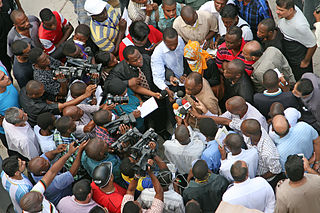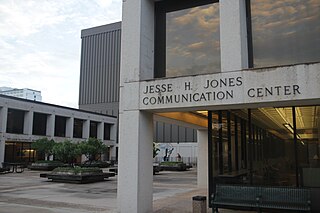Related Research Articles

The George Foster Peabody Awards program, named for the American businessman and philanthropist George Peabody, honor what are described as the most powerful, enlightening, and invigorating stories in television, radio, and online media. The awards were conceived by the National Association of Broadcasters in 1938 as the radio industry's equivalent of the Pulitzer Prizes. Programs are recognized in seven categories: news, entertainment, documentaries, children's programming, education, interactive programming, and public service. Peabody Award winners include radio and television stations, networks, online media, producing organizations, and individuals from around the world.

Broadcasting is the distribution of audio or video content to a dispersed audience via any electronic mass communications medium, but typically one using the electromagnetic spectrum, in a one-to-many model. Broadcasting began with AM radio, which came into popular use around 1920 with the spread of vacuum tube radio transmitters and receivers. Before this, most implementations of electronic communication were one-to-one, with the message intended for a single recipient. The term broadcasting evolved from its use as the agricultural method of sowing seeds in a field by casting them broadly about. It was later adopted for describing the widespread distribution of information by printed materials or by telegraph. Examples applying it to "one-to-many" radio transmissions of an individual station to multiple listeners appeared as early as 1898.

The Daughters of Bilitis, also called the DOB or the Daughters, was the first lesbian civil and political rights organization in the United States. The organization, formed in San Francisco in 1955, was conceived as a social alternative to lesbian bars, which were subject to raids and police harassment. As the DOB gained members, their focus shifted to providing support to women who were afraid to come out. The DOB educated them about their rights and about gay history. The historian Lillian Faderman declared, "Its very establishment in the midst of witch-hunts and police harassment was an act of courage, since members always had to fear that they were under attack, not because of what they did, but merely because of who they were." The Daughters of Bilitis endured for 40 years, becoming an educational resource for lesbians, gay men, researchers and mental health professionals.

Lesbian feminism is a cultural movement and critical perspective that encourages women to focus their efforts, attentions, relationships, and activities towards their fellow women rather than men, and often advocates lesbianism as the logical result of feminism. Lesbian feminism was most influential in the 1970s and early 1980s, primarily in North America and Western Europe, but began in the late 1960s and arose out of dissatisfaction with the New Left, the Campaign for Homosexual Equality, sexism within the gay liberation movement, and homophobia within popular women's movements at the time. Many of the supporters of Lesbianism were actually women involved in gay liberation who were tired of the sexism and centering of gay men within the community and lesbian women in the mainstream women's movement who were tired of the homophobia involved in it.
American Public Media Group, formerly the Minnesota Communications Group, is the non-profit parent organization of Minnesota Public Radio, American Public Media, and Southern California Public Radio. Jean Taylor is APMG's President and CEO.
Media democracy is a democratic approach to media studies that advocates for the reform of mass media to strengthen public service broadcasting and develop participation in alternative media and citizen journalism in order to create a mass media system that informs and empowers all members of society and enhances democratic values.

Broadcast journalism is the field of news and journals which are broadcast by electronic methods instead of the older methods, such as printed newspapers and posters. It works on radio, television and the World Wide Web. Such media disperse pictures, visual text and sounds.
The Lavender Menace was an informal group of lesbian radical feminists formed to protest the exclusion of lesbians and their issues from the feminist movement at the Second Congress to Unite Women in New York City on May 1, 1970. Members included Karla Jay, Martha Shelley, Rita Mae Brown, Lois Hart, Barbara Love, Ellen Shumsky, Artemis March, Cynthia Funk, Linda Rhodes, Arlene Kushner, Ellen Broidy, and Michela Griffo, and were mostly members of the Gay Liberation Front (GLF) and the National Organization for Women (NOW).

NLGJA: The Association of LGBTQ+ Journalists, is an American professional association dedicated to coverage of LGBTQ issues in the media. It is based in Washington, D.C., and the membership consists primarily of journalists, students, educators, and communications professionals. The organization was previously known as the National Lesbian and Gay Journalists Association (NLGJA), but changed its name in 2013 to "NLGJA: The Association of LGBT Journalists" to reflect the diversity of the communities it represents. In 2016, it added a "Q", updating its name to "NLGJA: The Association of LGBTQ Journalists". In 2023, it added a "+", updating its name to "NLGJA: The Association of LGBTQ+ Journalists".
Black feminism, also known as Afro-feminism chiefly outside the United States, is a branch of feminism that focuses on the African-American woman's experiences and recognizes the intersectionality of racism and sexism. Black feminism also acknowledges the additional marginalization faced by black women due to their social identity.
The feminist sex wars, also known as the lesbian sex wars, sex wars or porn wars, are terms used to refer to collective debates amongst feminists regarding a number of issues broadly relating to sexuality and sexual activity. Differences of opinion on matters of sexuality deeply polarized the feminist movement, particularly leading feminist thinkers, in the late 1970s and early 1980s and continue to influence debate amongst feminists to this day.

The National Organization for Women (NOW) is an American feminist organization. Founded in 1966, it is legally a 501(c)(4) social welfare organization. The organization consists of 550 chapters in all 50 U.S. states and in Washington, D.C. It is the largest feminist organization in the United States with around 500,000 members. NOW is regarded as one of the main liberal feminist organizations in the US, and primarily lobbies for gender equality within the existing political system. NOW campaigns for constitutional equality, economic justice, reproductive rights, LGBTQIA+ rights and racial justice, and against violence against women.

The feminist art movement in the United States began in the early 1970s and sought to promote the study, creation, understanding and promotion of women's art. First-generation feminist artists include Judy Chicago, Miriam Schapiro, Suzanne Lacy, Judith Bernstein, Sheila de Bretteville, Mary Beth Edelson, Carolee Schneeman, Rachel Rosenthal, and many other women. They were part of the Feminist art movement in the United States in the early 1970s to develop feminist writing and art. The movement spread quickly through museum protests in both New York and Los Angeles, via an early network called W.E.B. that disseminated news of feminist art activities from 1971 to 1973 in a nationally circulated newsletter, and at conferences such as the West Coast Women's Artists Conference held at California Institute of the Arts and the Conference of Women in the Visual Arts, at the Corcoran School of Art in Washington, D.C..

The Moody College of Communication is the communication college at The University of Texas at Austin. The college is home to top-ranked programs in advertising and public relations, communication studies, communication and leadership, speech, language and hearing sciences, journalism, and radio-television-film. The Moody College is nationally recognized for its faculty members, research and student media. It offers seven undergraduate degrees, including those in Journalism, Advertising, and Radio-Television-Film, and 17 graduate programs. The Moody College of Communication operates out of the Jesse H. Jones Communication Complex and the Dealey Center for New Media, which opened in November 2012.
The School of Communication and Information (SC&I) is a professional school within the New Brunswick Campus of Rutgers, The State University of New Jersey. The school was created in 1982 as a result of a merger between the Graduate School of Library and Information Studies, the School of Communication Studies, and the Livingston Department of Urban Journalism. The school has about 2,500 students at the undergraduate, masters, and doctoral levels, and about 60 full-time faculty.
The Combahee River Collective (CRC) ( kəm-BEE) was a Black feminist lesbian socialist organization active in Boston, Massachusetts from 1974 to 1980. The Collective argued that both the white feminist movement and the Civil Rights Movement were not addressing their particular needs as Black women and more specifically as Black lesbians. Racism was present in the mainstream feminist movement, while Delaney and Manditch-Prottas argue that much of the Civil Rights Movement had a sexist and homophobic reputation.
Radical lesbianism is a lesbian movement that challenges the status quo of heterosexuality and mainstream feminism. It arose in part because mainstream feminism did not actively include or fight for lesbian rights. The movement was started by lesbian feminist groups in the United States in the 1950s and 1960s. A Canadian movement followed in the 1970s, which added momentum. As it continued to gain popularity, radical lesbianism spread throughout Canada, the United States, and France. The French-based movement, Front des Lesbiennes Radicales, or FLR, organized in 1981 under the name Front des Lesbiennes Radicales. Other movements, such as Radicalesbians, have also stemmed off of the larger radical lesbianism movement. In addition to being associated with social movements, radical lesbianism also offers its own ideology, similar to how feminism functions in both capacities.
The Lesbian Organization of Toronto was a lesbian organization founded in 1976 and disbanded in 1980. The group was Toronto's first openly lesbian feminist group, and its members elected to open Canada's first Lesbian Centre.

News is information about current events. This may be provided through many different media: word of mouth, printing, postal systems, broadcasting, electronic communication, or through the testimony of observers and witnesses to events. News is sometimes called "hard news" to differentiate it from soft media.
The Gay Women's Alternative, DC (GWA) (1981–1993) was an incorporated social-educational non-profit organization dedicated to enriching the cultural, intellectual, and social lives of lesbians of the Washington, D.C., area. The GWA was formed in 1980 to provide the DC lesbian community with an alternative and safe space to socialize and discuss feminist and educational topics concerning the lesbian and gay women population. The group met every Wednesday evening from 8 pm to 11 pm at the Washington Ethical Society near Silver Spring, Maryland. Weekly programs covered topics such as, "Organizing Your Finances for Success," "Lesbian Couples: How Different are we?" and "Women and Wellness: A Feminist Approach to Health Care". Speakers included black poet Audre Lorde, artist Joan E. Biren, television journalist Maureen Bunyan, and comedian Kate Karsten. The GWA held several dances, including the annual lesbian spring dance and the Spring Cotillion.
References
- ↑ Maeda, Sheri; Rankin, Moira; Reuss, Natalie (1976). "Mayday Mayday". Quest: a feminist quarterly. p. 18.
- 1 2 3 Allen, Martha (1988). "The Development of Communication Networks Among Women, 1963-1983: Chapter 7". Women's Institute for Freedom of the Press. Retrieved 4 April 2023.
- ↑ Poppe, Terre (March 1979). "feminist radio network". Off Our Backs. 9 (3): 21. JSTOR 25792930.
- ↑ Jansen, Eric (1995). "How We Are Seen, How We See Ourselves". Out in All Directions: A Treasury of Gay and Lesbian America. Warner Books, Inc. p. 129.
- ↑ Byerly, Carolyn M.; Ross, Karen (2006). Women & Media: A Critical Introduction. Blackwell Publishing. p. 149.